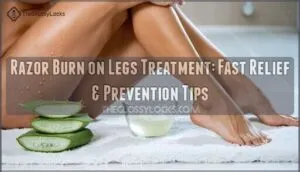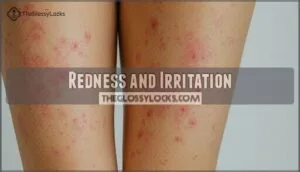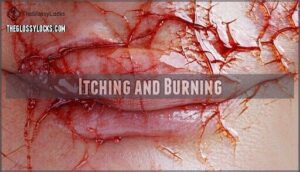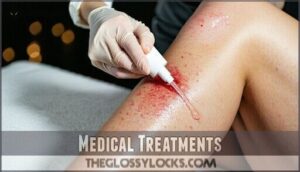This site is supported by our readers. We may earn a commission, at no cost to you, if you purchase through links.

Apply a cold compress for 10-15 minutes to reduce swelling and calm angry skin. Aloe vera gel provides instant cooling comfort, while tea tree oil mixed with water fights inflammation.
For stubborn irritation, over-the-counter hydrocortisone cream tackles itching and redness effectively.
Avoid shaving until your skin heals completely – typically 2-3 days.
The secret lies in choosing the right treatment based on your symptoms’ severity and knowing which mistakes could make things worse, to get fast relief that actually works and to achieve complete healing.
Table Of Contents
- Key Takeaways
- Causes of Razor Burn
- Symptoms and Signs
- Home Remedies
- Medical Treatments
- Prevention Methods
- Frequently Asked Questions (FAQs)
- How to get rid of razor burn on legs quickly?
- How long does razor burn on legs take to heal?
- How long does razor burn last on legs?
- Can razor burn lead to permanent scarring?
- When should you see a doctor for razor burn?
- Is razor burn contagious to other people?
- Can certain medications worsen razor burn symptoms?
- Conclusion
Key Takeaways
- Apply cold compresses immediately – You’ll get fast relief by placing a cold compress on razor burn for 10-15 minutes to reduce swelling and numb the pain.
- Use aloe vera gel and hydrocortisone cream – You can soothe irritated skin with aloe vera’s cooling properties, while hydrocortisone cream tackles stubborn redness and itching effectively.
- Avoid shaving until you’re healed – You’ll prevent further irritation by waiting 2-3 days before shaving again, giving your skin time to recover completely.
- Master proper shaving technique – You’ll prevent future razor burn by using sharp blades, shaving with the grain, and preparing your skin with warm water and pre-shave oil.
Causes of Razor Burn
Razor burn happens when you shave incorrectly or use the wrong tools for your skin type.
Poor technique, dull blades, dry shaving, and shaving too often can all irritate your leg skin and cause painful burning sensations.
Shaving Techniques
Poor shaving techniques cause most leg razor burn cases. Your stroke direction, blade angle, and razor pressure directly impact skin irritation.
Your technique matters more than your razor – master the basics to prevent painful irritation.
Key technique mistakes that trigger razor burn:
- Shaving against hair growth direction
- Applying excessive pressure on razor
- Using dull or dirty blades
- Skipping pre-shave routine steps
Master proper shaving techniques for smoother legs. Use light pressure and follow hair growth patterns. Choosing the best razors for legs can also minimize irritation. Your pre-shave routine and post-shave care matter equally for preventing razor burn treatment needs.
Razor Type and Quality
Your razor’s design directly affects razor burn risk. Dull blades tug at hair instead of cutting cleanly, creating irritation. Multi-blade razors can over-shave sensitive leg skin, while single blades offer gentler cuts.
| Razor Feature | Impact on Razor Burn |
|---|---|
| Blade Material | Stainless steel stays sharper longer than carbon steel |
| Razor Design | Open combs expose more blade, increasing aggression |
| Single Blade | Less likely to cause irritation than multi-blade systems |
| Multi-Blade | Can lift and re-cut hairs, causing razor burn |
| Razor Maintenance | Clean, sharp blades prevent tugging and irritation |
Quality razor brands invest in better blade coatings and precision manufacturing. This means smoother glides across your skin. Cheap disposables often have rough edges that scrape rather than slice. For leg razor burn treatment, switching to a well-maintained single-blade safety razor can make a significant difference in your shaving experience. Improper shaving can lead to ingrown hair causes.
Skin Preparation
Skipping proper preparation sets the stage for shaving irritation and razor burn remedies become necessary.
Warm water softens hair follicles while gentle exfoliating legs removes dead skin cells. Hydration importance can’t be overstated – dry skin tears easily.
Apply pre-shave oil before shaving cream for extra protection. This simple routine prevents shaving rash legs before it starts, and understanding the hydration importance is key.
Shaving Frequency
Too much shaving creates a vicious cycle that damages your legs.
Your skin needs recovery time between sessions, but daily shaving prevents proper healing.
Here’s how frequency affects your skin:
- Hair Regrowth – Shaving before hair reaches surface level increases ingrown hairs
- Skin Sensitivity – Daily shaving strips protective oils, causing chronic irritation
- Seasonal Adjustments – Winter legs need less frequent shaving than summer exposure
- Optimal Frequency – Every 2-3 days allows skin barrier restoration
- Frequency vs. Exfoliation – Over-shaving acts like aggressive scrubbing, triggering red bumps legs
Finding your sweet spot prevents shaving rash legs and razor burn remedies become unnecessary.
Symptoms and Signs
You’ll notice razor burn symptoms immediately after shaving or within a few hours.
The most common signs include red, inflamed skin that feels tender to touch, along with itching, burning sensations, and small raised bumps that may develop into ingrown hairs.
The symptoms can be uncomfortable and may require special care to alleviate the discomfort and prevent further irritation.
Redness and Irritation
After your razor glides across your legs, you might notice telltale signs that something’s gone wrong.
Your skin rebels immediately when shaving goes sideways, turning smooth legs into an angry red battlefield.
Redness spreads like a sunburn across freshly shaved skin. This inflammation severity varies from person to person based on skin sensitivity and your post-shave care routine.
| Redness Level | Appearance | Duration |
|---|---|---|
| Mild | Light pink patches | 30 minutes – 2 hours |
| Moderate | Bright red areas with warmth | 2-6 hours |
| Severe | Deep red with possible swelling | 6-24 hours |
| Very Severe | Dark red with raised bumps | 1-3 days |
| Extreme | Purple-red with blistering | 3+ days |
Your shaving rash legs display obvious irritation relief needs. Red bumps legs often accompany the redness.
These signs differ from ingrown hair legs or folliculitis legs conditions. Soothing skin becomes your priority when redness duration extends beyond normal healing time.
Itching and Burning
You’ll feel the familiar itch creeping across your legs after shaving.
This burning sensation signals your skin’s angry response to razor trauma.
Severity Levels range from mild tingling to intense discomfort.
Irritation Duration typically lasts 24-48 hours.
Pain Management becomes essential when itchy legs after shaving disrupts your day.
Watch for Infection Signs like increased warmth or pus.
Your Skin Sensitivity determines how intensely you’ll experience these symptoms.
Improper shaving can lead to redness and inflammation, causing intense discomfort.
Bumps and Ingrown Hairs
Bumps appear when hair curls back into your skin after shaving, creating those annoying raised spots on your legs.
These follicle inflammation episodes often lead to cysts formation if bacteria enters the area.
Without proper infection prevention, you risk scarring risks and hyperpigmentation that leaves dark marks.
Those itchy legs after shaving signal trouble brewing beneath the surface.
Smart shaving tips legs include proper home remedies and gentle leg treatment techniques to keep your shaving routine bump-free.
Home Remedies
You can treat razor burn at home with simple remedies that reduce inflammation and speed healing. These natural solutions work quickly to soothe irritated skin and prevent further damage.
Cold Compress
When razor burn strikes your legs, cold compress is your quick-fix friend.
The cold temperature reduces inflammation and numbs pain for immediate relief.
Apply for 10-15 minutes at a time.
- Compress Materials: Use a damp washcloth, ice pack wrapped in fabric, or frozen peas
- Application Frequency: Apply every 2-3 hours during the first day for best results
- Compress Duration: Keep it on for 10-15 minutes maximum to avoid skin damage
Cold vs. ice matters for skin sensitivity.
Direct ice can cause frostbite, so always use a barrier.
This simple leg treatment works fast when shaving tips go wrong.
For added soothing benefits, consider incorporating aloe vera gel after the cold compress.
Aloe Vera Gel
Aloe vera gel provides gentle relief for razor burn. This natural plant extract contains anti-inflammatory compounds that cool and soothe irritated skin.
Apply pure aloe gel directly to affected areas for immediate comfort. The gel’s moisturizing properties help heal damaged skin while reducing redness.
Choose products with minimal additives for sensitive skin care. Various aloe products are available for purchase.
Fresh aloe from the plant works best for postshave care treatment, providing the most effective form of natural relief.
Tea Tree Oil
Natural healing begins with TTO properties – powerful antibacterial and anti-inflammatory compounds that tackle postshave care head-on.
Mix 1-3 drops per teaspoon of carrier oil for safe TTO application on sensitive skin. This blend soothes shaving irritation while moisturizing legs.
TTO side-effects include potential allergic reactions, so test first. TTO concentrations range from 5-50% in commercial products.
Consider TTO alternatives like coconut oil for gentler shaving advice. Some users prefer essential oils for shaving due to their natural properties.
Baking Soda
Kitchen pantry-staple baking soda creates an alkaline paste that neutralizes acidic irritation from razor burn.
Mix equal parts baking soda and water to form a gentle paste. Apply using circular motions, avoiding scrubbing sensitive skin.
Let it sit for five minutes before rinsing thoroughly with cool water.
This Application Methods works well for those seeking smooth legs shaving without harsh chemicals or expensive treatments.
Medical Treatments
When home remedies aren’t enough, medical treatments can provide faster relief for severe razor burn on your legs.
Over-the-counter and prescription options target inflammation and prevent infection to speed up healing.
Topical Creams
Medicated topical creams offer targeted relief for razor burn on legs.
Look for cream ingredients like aloe vera, shea butter, and ceramides that soothe irritated skin. Popular cream types include fragrance-free emollient creams from CeraVe and Cetaphil, or colloidal oatmeal products from Aveeno.
As a home remedy, consider using aloe vera for its soothing and anti-inflammatory properties.
Application frequency should be two to three times daily for sensitive skin shaving recovery. Brand comparison shows drugstore options work as well as premium aftershave for women products for smooth legs shaving.
Hydrocortisone
Hydrocortisone cream provides quick relief for razor burn inflammation.
Over-the-counter versions contain 0.5-1% Hydrocortisone Strength, while stronger prescriptions reach 2.5%.
Apply thin layers twice daily, avoiding overuse which causes skin thinning.
Side Effects include temporary stinging or dryness.
Those with sensitive skin shaving should test patches first.
Alternative Steroids like betamethasone work for severe cases, though Pediatric Use requires doctor approval for children under two.
Antibiotic Ointments
When bacterial infections threaten razor-burned skin, antibiotic ointments provide targeted relief.
Apply products like Neosporin or Polysporin sparingly to affected areas after cleansing. These shaving product recommendations contain bacitracin and polymyxin B, preventing secondary infections in micro-abrasions.
Watch for side effects like redness or itching. Ointment resistance can develop with overuse, so limit application to 1-3 times daily for preventative use only.
Prescription Medications
When severe razor burn doesn’t respond to over-the-counter treatments, your doctor’s prescription arsenal kicks in.
Topical steroids calm angry inflammation fast. Oral antibiotics tackle bacterial infections lurking beneath bumps.
Pain relievers and anti-inflammatories offer systemic relief. Retinoid creams prevent future ingrown hairs by keeping pores clear.
Don’t suffer through stubborn razor burn alone. For severe cases, doctors might suggest topical retinoids to accelerate skin cell turnover.
Prevention Methods
You can prevent razor burn on your legs by making smart choices before, during, and after shaving. The right preparation and technique will keep your skin smooth and irritation-free.
Exfoliating Skin
Exfoliation removes dead skin cells that trap razors and cause irritation. This simple step creates a smooth surface for your blade to glide across.
Choose your exfoliation method based on your skin’s needs and shaving preferences.
- Physical Exfoliation: Use gentle scrubs or exfoliating mitts before shaving
- Chemical Exfoliation: Apply glycolic or salicylic acid products 1-3 times weekly
- Post-Exfoliation Care: Moisturize immediately after to maintain skin barrier protection. For smoother legs, consider a dedicated exfoliating scrub.
Shaving in Direction
Following the grain of your hair growth prevents razor burn and irritation.
Map your hair’s natural direction before shaving. Start with the grain for your first pass.
This reduces blade exposure against stubborn follicles. Multi-pass shaving works best when you respect directional benefits.
Going against grain too early increases razor aggressiveness and cut risk, which is why respecting the grain is crucial.
Using Sharp Razors
Dull blades drag against skin, creating friction that leads to irritation.
Sharp razors cut hair cleanly without tugging.
Replace disposable razors after 5-7 uses.
Different blade materials offer varying sharpness levels.
Stainless steel blades stay sharp longer than basic carbon steel.
Check your razor’s cutting angle – it affects shaving efficiency.
Higher razor aggressiveness requires careful blade exposure adjustment for sensitive skin.
Avoiding Tight Clothing
Tight clothing after shaving creates friction against freshly shaved skin.
Choose loose-fitting pants and breathable fabrics like cotton.
Your clothing fit matters for post-shave comfort.
Avoid synthetic materials that trap heat and moisture.
Consider alternative styles like flowing skirts when your activity level allows.
Proper fabric choice prevents irritation and supports shaving smoothness while your skin heals, ensuring overall post-shave comfort.
Frequently Asked Questions (FAQs)
How to get rid of razor burn on legs quickly?
Cool compresses soothe inflamed skin immediately. Apply aloe vera gel or hydrocortisone cream to reduce redness and irritation. Avoid tight clothing and let your skin breathe for faster healing.
How long does razor burn on legs take to heal?
Like a fire slowly dimming, razor burn typically heals within 2-5 days with proper care.
You’ll notice improvement after 24-48 hours, but complete healing depends on severity and your skin’s natural recovery speed.
How long does razor burn last on legs?
Razor burn on your legs typically lasts two to five days with proper care. You’ll notice redness and irritation fade gradually as your skin heals naturally and recovers.
Can razor burn lead to permanent scarring?
Sarah watched in dismay as dark spots formed where her razor burn had been months ago.
While severe razor burn can potentially cause scarring, it’s uncommon with proper care and typically fades completely with gentle treatment and time.
When should you see a doctor for razor burn?
See a doctor if you experience severe pain, pus, spreading red streaks, fever, or if the burn doesn’t improve after three days of home treatment.
Is razor burn contagious to other people?
No, razor burn isn’t contagious. It’s your skin’s reaction to irritation from shaving, not an infection. You can’t spread it through touch or contact.
Can certain medications worsen razor burn symptoms?
One in four people on blood thinners experience worsened razor burn.
You’re more vulnerable if you take retinoids, acne medications, or blood thinners—they make your skin thinner and slower to heal, turning minor irritation into angry inflammation.
Conclusion
Beautiful legs deserve proper care after shaving mishaps strike.
Effective razor burn on legs treatment starts with immediate cooling relief through cold compresses and aloe vera gel. Don’t underestimate tea tree oil‘s anti-inflammatory power or hydrocortisone cream for stubborn cases.
Prevention beats treatment every time – sharp razors, proper technique, and gentle skin preparation work wonders. Remember to let your skin heal completely before shaving again, typically requiring two to three days of patience.
- https://health.clevelandclinic.org/how-to-heal-razor-burn
- https://borealisderm.com/in-the-news/skin-experts-reveal-the-best-products-for-razor-burn-and-bumps/
- https://forgottenskincare.com/blogs/forgotten-places/how-to-treat-razor-burn
- https://www.verywellhealth.com/razor-burn-on-legs-8648545
- https://www.gillettevenus.com/en-us/womens-shaving-guide/sensitive-skin/shaving-rashes-and-bumps/












